Documents: Go to download!
User Manual
- User Manual - (English, French, Spanish)
- Product Specifications - (English)
- energy guide - (English)
OWNER’S MANUAL Air Conditioner
INSTALLATION INSTRUCTIONS
LOCATION

- This air conditioner is designed for easy installation in single or double hung windows. Since window designs vary, it may be necessary to make some modifi cations for safe installation.
- This air conditioner is not designed for vertical, slider type windows or “through the wall” installation.
- Ensure that the window and frame are structurally sound and free from dry or rotted wood.
- Install the air conditioner in a window on a side of the building which favors more shade than sunlight. If the appliance must be in direct sunlight, it is advisable to provide a shade awning over the appliance to ensure efficient functioning.
- Do not install the appliance where leakage of combustible gas is suspected.
- This appliance is designed to evaporate condensation under normal conditions. Under extremely hot or humid conditions, excess condensation may overflow to the outside. The appliance should be installed where condensation cannot drip on pedestrians or neighboring properties.
- Provide sufficient clearance around the appliance to allow ample air circulation. The rear of the appliance should be outdoors, it should not be in a garage or another room. Keep the appliance away from obstacles and at least 76 cm (30 inches) above the ground. Ensure that curtains and other obstructions do not block air flow to the appliance.
ELECTRIC SHOCK HAZARD
- To avoid the possibility of personal injury, disconnect power to the appliance before installing or servicing.
REQUIRED TOOLS
- Screwdrivers: Phillips and flat head.
- Power Drill: 3.2mm (1/8 inch) diameter drill bit
- Pencil
- Measuring Tape
- Scissors
- Carpenter’s Level
Note: Save the shipping carton and packing materials for future storage or transportation. Remove the plastic bag from the carton containing the installation hardware kit necessary for the installation of your air conditioner. Please check the contents of the hardware kit against the corresponding model check list, prior to installation of the appliance.
INCLUDED ACCESSORIES
- 13 mm (1/2 inch) screws (x7)
- 9.5 mm (3/8 inch) screws (x4)
- Adhesive foam seal
- Regular foam seal
- Safety lock
- “L” shaped mounting bracket
- Sash bracket for wood windows (x2)
- Sash bracket for vinyl windows (x2)
- Side curtains
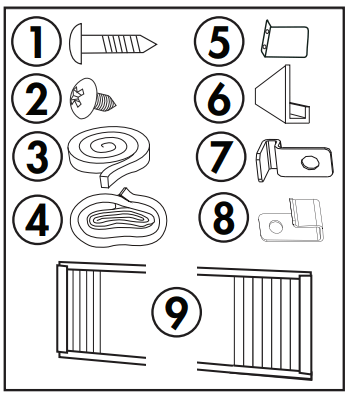
ASSEMBLY
Note: Images in this manual are for instructional purposes only. The actual shape of the appliance may vary slightly.
Install the “L” Shaped Bracket
- Attach the “L” shaped bracket to the top of the cabinet as shown below using the provided 9.5 mm (3/8 inch) screws (x4).
- Note: The “L” shaped bracket may come factory installed on some models.
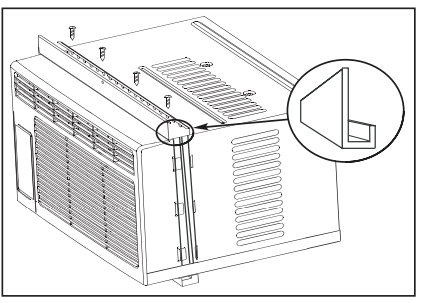
Install the Side Curtains
- Attach the side curtains to the cabinet by sliding the curtain frame into the side channel of the cabinet as shown below.
- The curtains are labeled “left” and “right on the frames. This refers to the left and right sides of the appliance when facing the front of the appliance.
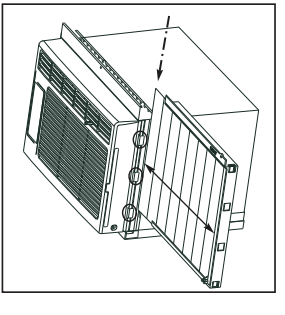
INSTALLATION
- Place the air conditioner into the window with the “L” shaped mounting bracket positioned in front of the upper sash. The bottom of the cabinet should be positioned on the recessed portion of the window frame. Pull the upper window sash down until it rests just behind the front flange of the “L” shaped mounting bracket.
- Expand the side curtains on each side and secure the top of the frames to the window sash using one 13 mm (1/2 inch) screw on each side of the “L” shaped mounting bracket.
- Attach the clamps on the lower part of each curtain to the window sill using one 13 mm (1/2 inch) screw on each side of the cabinet.

- Place the adhesive foam seal into the opening between the inside and outside windows and attached the safety lock to the outside window frame using two 13 mm (1/2 inch) screws.
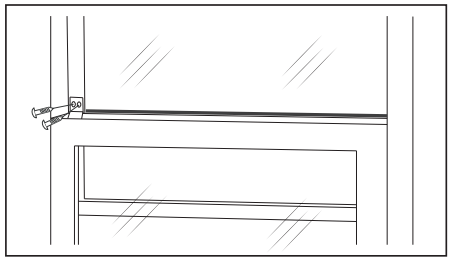
Check the Tilt Angle
- The air conditioner should be tilted downward towards the outside approximately 3° to 4°. This tilt will encourage any condensed water to drain to the outside. If any condensed water leaks to the inside of the house, check the tilt angle and adjust as necessary.
- Measure the tilt angle from the front of the cabinet’s edge. The difference in height between the front and the back of the appliance, labeled “A” on the image below, should be approximately 19 mm - 2.5 cm (3/4 inch - 1 inch).
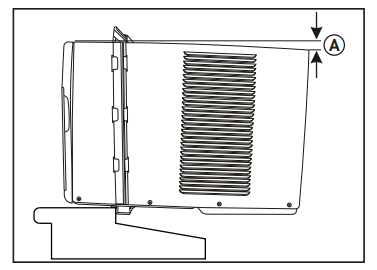
CAUTION: The compressor is located on the left side of the appliance, on the same side as the controls. This side of the appliance will be heavier and more awkward to manipulate. Inadequate support on the control side of the appliance can result in personal injury and damage to the appliance and your property. It is recommended that you have someone assist you during the installation of this appliance.
OPERATING INSTRUCTIONS
FEATURES
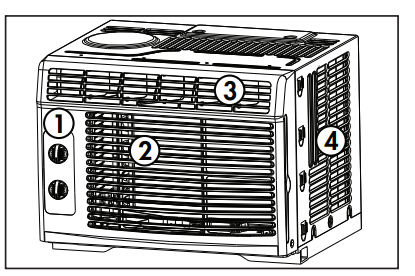
1. Control Panel
2. Interior Air Inlet
3. Interior Air Outlet
4. Exterior Air Inlet
5. Air Filter (not pictured)
CONTROL PANEL
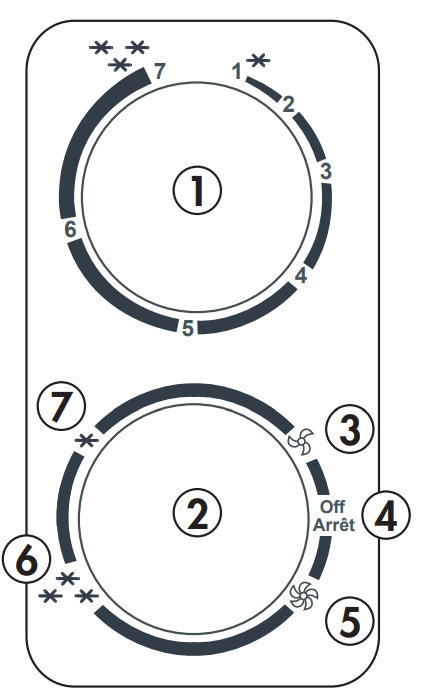
1. Thermostat dial: Used to choose the level of cooling.
- The lower numbers indicate warmer settings.
- The higher numbers indicate colder settings.
2. Program selector dial: Used to select which program the appliance will run.
3. Low fan: This setting will circulate air at low speed without engaging the cooling function.
4. Off/Arrêt: This setting will turn the appliance off.
5. High fan: This setting will circulate air at a high speed without engaging the cooling function.
6. High cool: This setting will provide cooling with high fan speed.
7. Low cool: This setting will provide cooling with low fan speed.
Note: Wait three minutes when switching programs to allow the appliance to adjust.
CARE & MAINTENANCE
AIR FILTER
The air filter should be cleaned approximately every 2 weeks. The air filter may require more frequent cleaning if there is significant dander or fur in the air. Follow the steps below to clean the filter and return the appliance to normal functioning. Ensure that the program selector dial is turned to “Off/Arrêt” and that the power cord is unplugged.
- The air filter is located behind the front intake grill. To remove the air filter, grasp the filter tab on the right side of the grill and slide it out to the right. If the front intake grill has two indents, pull the grill forward to remove the air filter.
- Use a vacuum cleaner with a soft brush attachment to remove any large debris or dust build up from the air filter.
- Wash the filter in lukewarm, soapy water, below 40°C (104°F), or use a neutral cleaning agent.
- Rinse the filter with clean water and dry thoroughly before reinstalling in the appliance.
Note: Do not operate the appliance without the air filter installed.
CLEANING
- To avoid possible electric shock, ensure that the appliance is unplugged before performing any cleaning or maintenance. The outside of the appliance can be wiped clean with a soft cloth or with a lukewarm, damp cloth if necessary.
- Do not use gasoline, benzene, thinner or any other chemicals to clean this appliance as these substances can cause damage to the finish and deformation of plastic parts.
- Never pour water directly onto the appliance as this will cause deterioration of electrical components and wiring insulation.
END OF SEASON CARE
- Before removing the appliance from service for the year, operate the appliance on high fan mode for half a day to ensure the inside of the appliance is dry. This will help avoid the growth of mold or mildew inside the appliance. Ensure the fi lter is clean and dry. Store the appliance covered in a dry location.
- Note: When installing or removing the appliance from the window, ensure that caution is taken to prevent it from falling backward. It is recommended that installation or removal is completed with assistance to prevent injury to persons or damage to property or the appliance.
DISPOSAL
- Check for local regulatory compliance regarding approved and safe disposal of this appliance.
TROUBLESHOOTING
| PROBLEM | POSSIBLE CAUSE |
| Appliance will not operate |
Plug is not fully inserted into the wall outlet Blown fuse or circuit breaker |
| Insufficient cooling |
Air filter is dirty Blocked airflow Appliance size is too small for application |
| Noise | Inadequate support in window installation |
| Odors |
Formation of mold or mildew on internal wet surfaces Place an algaecide tablet in base pan; push the tablet through the grill on either side of the appliance |
| Water dripping inside | Appliance is not properly angled to allow water to drain to the outside |
| Water dripping outside | On very hot or humid days dripping water from the back of the appliance is normal |
| Frost build up |
When outdoor temperatures are below 18.3°C (65°F) frost may form when the appliance is in cooling mode Switch the appliance to fan only mode until the frost melts |
Important Safety Information
SAFETY REQUIREMENTS
DANGER: Risk of fire or explosion. Flammable refrigerant used. Do not damage the refrigerant circuit.
- Ensure that servicing is done by factory-authorized service personnel, to minimize product damage or safety issues.
- Consult repair manual or owner’s guide before attempting to service this product. All safety precautions must be followed.
- Dispose of properly in accordance with federal or local regulations.
- Follow handling instructions carefully.
- Keep ventilation openings, in the appliance clear of obstruction.
- Do not use mechanical devices or other means to accelerate the defrosting process.
- Children should be supervised to ensure that they do not play with the appliance.
- Do not store or install the appliance near continuously operating ignition sources such as open flames or a gas stove.
- Do not operate near water or in a wet room.
- Do not pierce or burn.
- Be aware that refrigerants may not contain an odor.
- The appliance must be stored so as to prevent mechanical damage from occurring.
All wiring must comply with local and national codes and must be installed by a qualified electrician. Check the available power supply and resolve any wiring problems before installing and operating this appliance.
The rating plate located on the right side of the appliance just above the power cord contains electrical and other technical data.
This appliance is not intended for use by persons (including children) whose physical, sensory or mental capabilities may be different or reduced, or who lack experience or knowledge, unless such persons receive supervision or training to operate the appliance by a person responsible for their safety
GROUNDING INSTRUCTIONS
- This appliance must be grounded. Grounding reduces the risk of electrical shock by providing an escape wire for the electrical current.
- This appliance has a cord that has a grounding wire with a 3-prong plug. The power cord must be plugged into an outlet that is properly grounded. If the outlet is a 2-prong wall outlet, it must be replaced with a properly grounded 3-prong wall outlet. The serial rating plate indicates the voltage and frequency the appliance is designed for.
- WARNING - Improper use of the grounding plug can result in a risk of electric shock. Consult a qualified electrician or service agent if the grounding instructions are not completely understood, or if doubt exists as to whether the appliance is properly grounded.
- Do not connect your appliance to extension cords or together with another appliance in the same wall outlet. Do not splice the power cord. Do not under any circumstances cut or remove the third ground prong from the power cord. Do not use extension cords or ungrounded (two prongs) adapters.
- If the power supply cord is damaged, it must be replaced by the manufacturer, its service agent or similar qualified person in order to avoid hazard.
CAUTION: RISK OF FIRE Flammable refrigerant used. When maintaining or disposing of the air conditioner, the refrigerant must not be allowed to vent into the open air
Any person involved with working on the refrigerant circuit should hold a current, valid certifi cate from an industry-accredited assessment authority that authorizes their competence to handle refrigerants safely in accordance with an industry-recognized assessment specification.
Servicing shall only be performed as recommended by the manufacturer. Maintenance and repair requiring the assistance of other skilled personnel shall be carried out under the supervision of the person competent in the use of flammable refrigerants.
When maintaining or disposing of the appliance the refrigerant must be recovered properly and should not be allowed to discharge to the air directly.
Information on servicing
- Checks to the area: Prior to beginning work on systems containing fl ammable refrigerants, safety checks are necessary to ensure that the risk of ignition is minimized. For repair to the refrigerating system, the following precautions shall be complied with prior to conducting work on the system.
- Work procedure: Work shall be undertaken under a controlled procedure so as to minimize the risk of a flammable gas or vapour being present while the work is being performed.
- General work area: All maintenance staff and others working in the local area shall be instructed on the nature of work being carried out. Work in confined spaces shall be avoided. The area around the work space shall be sectioned off. Ensure that the conditions within the work area have been made safe by removing all flammable material.
- Checking for the presence of refrigerant: The are shall be checked with an appropriate refrigerant detector prior to and during work to ensure the technician is aware of potentially flammable atmospheres. Ensure that the leak detection equipment being used is suitable for use with flammable refrigerants, i.e. nonsparking, adequately sealed and intrinsically safe.
- Presence of fire extinguisher: If any hot work is to be conducted on the refrigeration equipment or any associated parts, appropriate fire extinguishing equipment shall be available to hand. Have a dry powder or C02 fire extinguisher adjacent to the work area.
- No ignition sources: No person carrying out work in relation to a refrigeration system which involves exposing any pipe work that contains or has contained flammable refrigerant shall use any sources of ignition in such a manner that it may lead to risk of fi re or explosion. All possible ignition sources including cigarette smoking, should be kept sufficiently far away from the site of installation, repairing, removing and disposal during which flammable refrigerant can possibly be released to the surrounding space. Prior to work taking place, the area around the equipment is to be surveyed to make sure there are no flammable hazards or ignition risks. No smoking signs shall be displayed.
- Ventilated area: Ensure that the area is in the open or that it is adequately ventilated before breaking into the system or conducting any hot work. A degree of ventilation shall continue during the period that the work is carried out. The ventilation should safely disperse any released refrigerant and preferable expel it externally into the atmosphere.
- Checks to the refrigeration equipment: Where electrical components are being changed, they shall be fit for the purpose and to the correct specification. At all times the manufacturer’s maintenance and service guidelines shall be followed. If in doubt consult the manufacturer’s technical department for assistance. The following checks shall be applied to installations using flammable refrigerants:
- The charge size is in accordance with the room size within which the refrigerant containing parts are installed.
- The ventilation machinery and outlets are operating adequately and are not obstructed.
- If an indirect refrigerating circuit is being used, the secondary circuit shall be checked for the presence of refrigerant.
- Marking to the equipment continues to be visible and legible. Markings and signs that become illegible must be corrected.
- Refrigeration pipe or components are installed in a position where they are unlikely to be exposed to any substance which may corrode refrigerant containing components, unless the components are constructed of materials which are inherently resistant to being corroded or are suitable protected against being corroded.
- Checks to electrical devices: Repair and maintenance to electrical components shall include initial safety checks and component inspection procedures. If a fault exists that could compromise safety, then no electrical supply shall be connected to the circuit until it is satisfactorily dealt with. If the fault cannot be corrected immediately but it is necessary to continue operation, an adequate temporary solution shall be used. This shall be reported to the owner of the equipment so all parties are advised.
Initial safety checks shall include:
- That capacitors are discharged. This shall be done in a safe manner to avoid possibility of sparking.
- That no live electrical components and wiring are exposed while charging, recovering or purging the system.
- That there is continuity of earth bonding.
Repairs to sealed components
- During repairs to sealed components, all electrical supplies shall be disconnected from the equipment being worked upon prior to any removal of sealed covers, etc. If it is absolutely necessary to have an electrical supply to equipment during servicing then a permanently operating form of leak detection shall be located at the most critical point to warn of a potentially hazardous situation.
- To ensure that by working on electrical components the casing is not altered in such a way that the level of protection is affected, particular attention shall be paid to the following:
- Damage to cables, excessive number of connections, terminals not made to original specifi cation, damage to seals, incorrect fitting of glands, etc.
- Ensure the apparatus is mounted securely.
- Ensure that seals or sealing materials have not degraded such that they no longer serve the purpose of preventing the ingress of flammable atmospheres. Replacement parts shall be in accordance with the manufacturer’s specifications.
Note: The use of silicon sealant may inhibit the effectiveness of some types of leak detection equipment. Intrinsically safe components do not have to be isolated prior to working on them.
Repair to intrinsically safe components
- Do not apply any permanent inductive or capacitance loads to the circuit without ensuring that this will not exceed the permissible voltage and current permitted for the equipment in use. Intrinsically safe components are the only types that can be worked on while live in the presence of a flammable atmosphere. The test apparatus shall be at the correct rating. Replace components only with parts specified by the manufacturer. Other parts may result in the ignition of refrigerant in the atmosphere from a leak.
Cabling
- Check that cabling will not be subject to wear, corrosion, excessive pressure, vibration, sharp edges or any other adverse environmental effects. The check shall also take into account the effects of aging or continual vibration from sources such as compressors or fans.
Detection of flammable refrigerants
- Under no circumstances shall potential sources of ignition be used in the searching for or detection of refrigerant leaks. A halide torch or any other detector using a naked flame shall not be used.
Leak detection methods
The following leak detection methods are deemed acceptable for systems containing flammable refrigerants:
- Electronic leak detectors shall be used to detect flammable refrigerants but the sensitivity may not be adequate or may need recalibration. Detection equipment shall be calibrated in a refrigerant-free area. Ensure that the detector is not a potential source of ignition and is suitable for the refrigerant used.
- Leak detection equipment shall be set at a percentage of the LFL of the refrigerant and shall be calibrated to the refrigerant employed and the appropriate percentage of gas (25% maximum) is confirmed.
- Leak detection fluids are suitable for use with most refrigerants but the use of detergents containing chlorine shall be avoided as the chlorine may react with the refrigerant and corrode the copper or pipe work.
- If a leak is suspected, all naked flames shall be removed or extinguished.
- If a leakage of refrigerant is found which requires brazing, all of the refrigerant shall be recovered from the system or isolated by means of shut off valves in a part of the system remote from the leak. Oxygen free nitrogen (OFN) shall then be purged through the system both before and during the brazing process.
Removal and evacuation
When breaking into the refrigerant circuit to make repairs or for any other purpose conventional procedures shall be used. However, it is important that the best practice is followed since flammability is a consideration. The following procedures shall be adhered to:
- Remove refrigerant.
- Purge the circuit with inert gas.
- Evacuate.
- Purge again with inert gas.
- Open the circuit by cutting or brazing.
- The refrigerant charge shall be recovered into the correct recovery cylinders. The system shall be flushed with OFN to render the unit safe. This process may need to be repeated several times. Compressed air or oxygen shall not be used for this task.
- Flushing shall be achieved by breaking the vacuum in the system with OFN and continuing to fill until the working pressure is achieved, then venting to atmosphere and finally pulling down to a vacuum. This process shall be repeated until no refrigerant is within the system. When the final OFN charge is used, the system shall be vented down to atmospheric pressure to enable work to take place. This operation is absolutely vital is brazing operations on the pipe-work are to take place.
- Ensure that the outlet for the vacuum pump is not close to any ignition sources and there is ventilation available.
Charging procedures
In addition to conventional charging procedures, the following requirements shall be followed:
- Ensure that contamination of different refrigerants does not occur when using charging equipment. Hoses or lines shall be as short as possible to minimize the amount of refrigerant contained in them.
- Cylinders shall be kept upright.
- Ensure that the refrigeration system is earthed prior to charging the system with refrigerant.
- Label the system when charging is complete, if not already labeled.
- Extreme care shall be taken not to overfill the refrigeration system.
- Prior to recharging the system it shall be pressure tested with OFN. The system shall be leak tested on completion of charging but prior to commissioning. A follow up leak test shall be carried out prior to leaving the site.
Decommissioning
Before carrying out this procedure, it is essential that the technician is completely familiar with the equipment in all its detail. It is recommended good practice that all refrigerants are recovered safely. Prior to the task being carried out, an oil and refrigerant sample shall be taken in case analysis is required prior to re-use of reclaimed refrigerant. It is essential that electrical power is available before the task is commenced.
- A. Become familiar with the equipment and its operation.
- B. Isolate system electrically.
- C. Before attempting the procedure ensure that:
- Mechanical handling equipment is available if required for handling refrigerant cylinders.
- All personal protective equipment is available and being used correctly.
- The recovery process is supervised at all times by a competent person.
- Recovery equipment and cylinders conform to the appropriate standards.
- D. Pump down refrigerant system, if possible.
- E. If a vacuum is not possible, make a manifold so that refrigerant can be removed from various parts of the system.
- F. Make sure that cylinder is situated on the scales before recovery takes place.
- G. Start the recovery machine and operate in accordance with the manufacturer’s instructions.
- H. Do not overfill cylinders. No more than 80% volume liquid charge.
- I. Do not exceed the maximum working pressure of the cylinder, even temporarily.
- J. When the cylinders have been filled correctly and the process is completed, make sure that the cylinders and the equipment are removed from the site promptly and all isolation valves on the equipment are closed off.
- K. Recovered refrigerant shall not be charged into another refrigeration system unless it has been cleaned and checked.
Labeling
- Equipment shall be labeled stating that it has been decommissioned and emptied of refrigerant. The label shall be dated and signed. Ensure that there are labels on the equipment stating the equipment contains flammable refrigerant.
Recovery
- When removing refrigerant from a system, either for servicing or decommissioning, it is recommended good practice that all refrigerants are removed safely.
- When transferring refrigerant into cylinders, ensure that only appropriate refrigerant recovers cylinders are employed. Ensure that the correct number of cylinders for holding the total system charge are available. All cylinders to be used are designed for the recovered refrigerant and labeled for that refrigerant, i.e. special cylinders for the recovery of refrigerant. Cylinders shall be complete with pressure relief valve and associated shut-off valves in good working order. Empty recovery cylinders are evacuated and, if possible, cooled before recovery occurs.
- The recovery equipment shall be in good working order with a set of instructions concerning the equipment that is at hand and shall be suitable for the recovery of flammable refrigerants. In addition, a set of calibrated weighing scales shall be available and in good working order. Hoses shall be complete with leak-free disconnect couplings and in good condition. Before using the recovery machine, check that is it in satisfactory working order, has been properly maintained and that any associated electrical components are sealed to prevent ignition in the event of a refrigerant leak. Consult the manufacturer if in doubt.
- The recovered refrigerant shall be returned to the refrigerant supplier in the correct recovery cylinder and the relevant waste transfer note shall be arranged. Do not mix refrigerants in recovery units and especially not in cylinders. If compressors or compressor oils are to be removed, ensure that they have been evacuated to an acceptable level to make certain that flammable refrigerant does not remain within the lubricant. The evacuation process shall be carried out prior to returning the compressor to the suppliers. Only electric heating to the compressor body shall be employed to accelerate this process. When oil is drained form a system, it shall be carried out safely.
See other models: DAC060BGUWDB DDR45B3WDB DBC117A2BSSDD-6 DPA120B6WDB-6 DAR016B1BM
